Back in the end of the 1940s, when Argentina was ruled by the very controversial President Juan Domingo Perón (he would eventually be taken out of the presidency by a military coup d’état in 1955), an interesting, but generally unknown, submachine gun project emerged in that part of the world. In 1949, shortly after his return from a trip to Europe, he met with leaders of the local CGT – Confederación General del Trabajo (National Labor Confederation) to propose the organization of armed Milicias Populares (Popular Militias) for additional people’s support to his government. Then, he needed a large volume of inexpensive guns to arm his followers so that internal political opposition might eventually be faced. The hard way.
A Buenos Aires-based company called Hispano-Argentina Fábrica de Automóviles S.A., HAFDASA for short, was given the task of designing and manufacturing such weapons. This appeared to be a fairly simple job, since that concern was a local licensee of Switzerland’s Hispano-Suiza for cars, trucks, buses, and general automotive parts, not to mention, of course, that it produced since 1938 the Ballester-Molina Modelo 1927, a Colt-authorized copy of the .45ACP M1911A1 pistol. More than that, HAFDASA also built a number of pistol-caliber (.45ACP and 9x19mm) semi-automatic carbines and submachine guns for local military and police use. What was expected to become (which it never did, in fact) the standard armament of the Milicias Populares appeared in prototype forms as the supposedly-designated “Pistola Ammetralladora Modelo 1949”, or Machine Pistol Model 1949. The same guns are also referred to as the “C.4” models, two different design variations having existed, but I have no solid information as to the exact – or even approximate – number of prototypes completed, all chambered to the 9x19mm round.

A low-quality illustration of a prototype fitted with an MP38/MP40-type foldable stock.
Instead of utilizing the general design of the different HAFDASA carbines, which had aluminum cast lower receivers, wooden stocks and other more expensive-to-make items, the creators of the expedient subguns came out with two different clones of the WWII-era British STEN submachine gun. What appears to have been the first model was fitted with a folding metal stock copied from the same-era’s German MP38/MP40, while the simple tubular receiver had the barrel of approximately 200mm largely protruding from it. The 32-round magazine fit, as expected, to the left side, while a somewhat decent wooden pistol grip was added, plus a smooth-contoured wooden, eh, grip forward of the trigger guard. The weapon weighed about 3.5kg and had a cyclic rate of fire in the 600 rounds/min region.
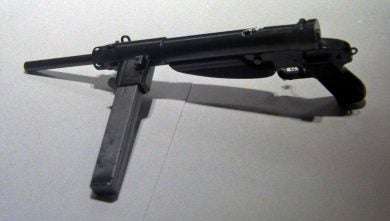
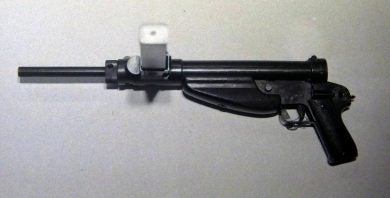
Believed to be the sole surviving example of its type, this prototype was originally fitted with a foldable stock copied from the German MP38/MP40.

Right side view of the same gun. Note slot cut in receiver to safely place the cocking handle in the open position, the so-called locking recess.

The prototype, 32-round magazine removed. The fire-selector was the typical push-through type, seen on the lower receiver side..
Another variant also existed, this featuring a detachable skeleton buttstock very similar to that used in some earlier STENs. With a 200mm barrel, the gun’s overall length was 790mm (530mm, stock removed), and reportedly had similar weight (3.5kg) and cyclic rate of fire (600 rounds/min) to the previously-described model.
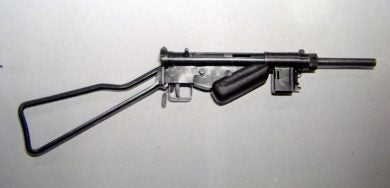
The even more STENish variant is shown here with the magazine housing rotated down, a feature intended to make it more compact, for transport.
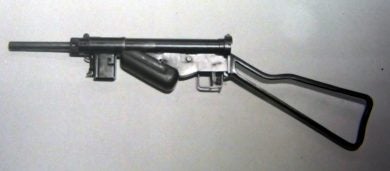
Left side view of the same HAFDASA prototype. Inclined wooden fixture on the lower receiver was apparently intended to work as a forward grip.
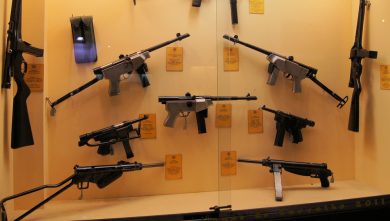
The two prototypes described in this article are shown in the lower part of a showcase of Museo de Armas de La Nación, in Buenos Aires. The other displayed weapons are different HAFDASA pistol-caliber carbines and SMGs. (Picture credit: Jonas de Carvalho, via flickr.com)
 Your Privacy Choices
Your Privacy Choices
